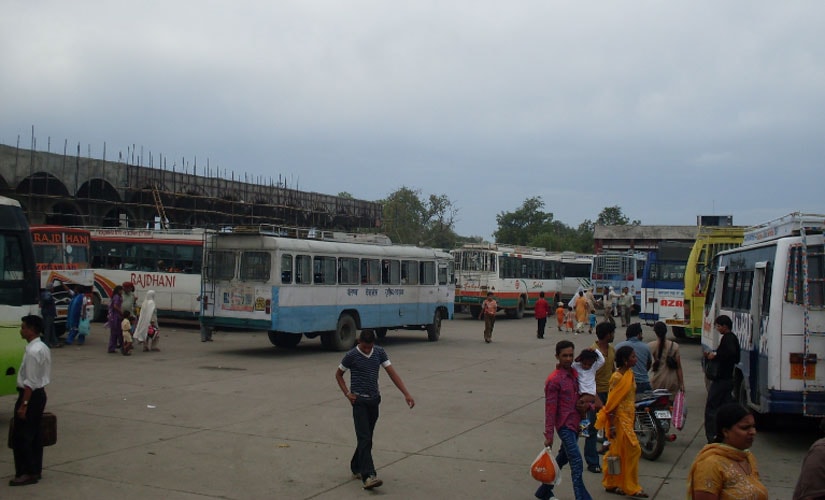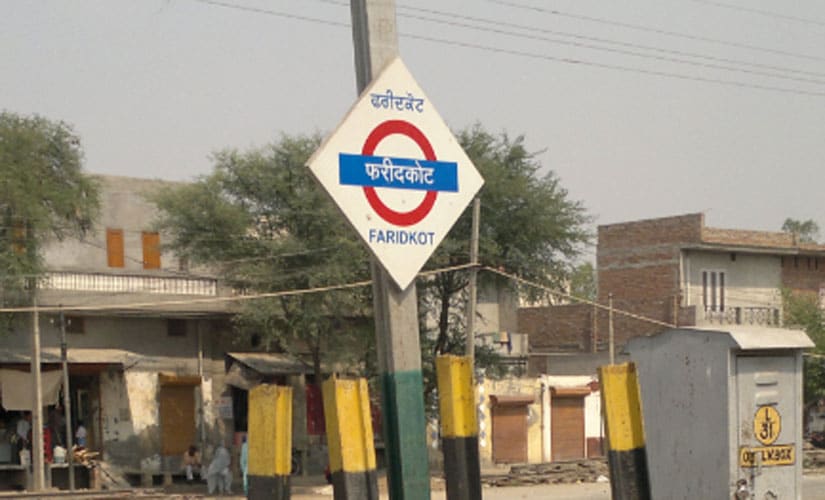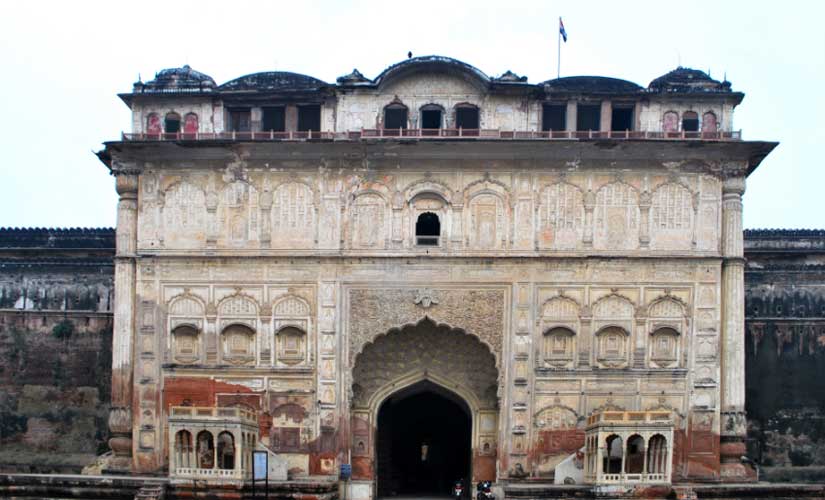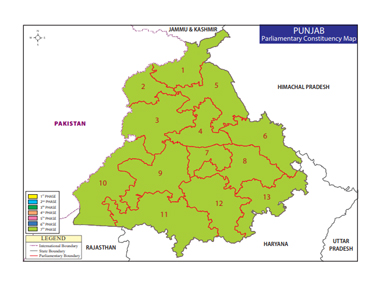The state of Punjab has a population of 2,77,43,338, comprising 1,46,39,465 males and 1,31,03,873 females as per Census 2011. There are 13 Lok Sabha seats and 117 Assembly constituencies in the state. Four Lok Sabha seats are reserved for the Scheduled Castes – Hoshiarpur, Faridkot, Fatehgarh Saheb and Jalandhar. The Scheduled Castes comprise 31.94 percent of the state population. In the 2014 Lok Sabha election, the Bharatiya Janata Party-Shiromani Akali Dal combine won six of the 13 seats in the state riding on the Narendra Modi-wave while the Aam Aadmi Party, a fledgeling outfit at that time, made its debut by winning four seats. The Congress had won just three seats. The Punjab Vidhan Sabha which has 117 seats. In the 2017 Assembly election, the Congress made a comeback by winning 77 seats, followed by the AAP which won 20 seats. SAD won 15 seats while the BJP had to make do with three seats. The Lok Insaaf Party won two seats as well. In the upcoming election, the Congress will look to capitalise on the Assembly election win while the BJP is keen on steering the conversation on the recent retaliation by the armed forces following the 14 February Pulwama terror strike. The present Congress government in the state will be hoping that the recent farm loan waiver and crackdown against gangsters and terror modules in the state will tip the scales in their favour in the 2019 polls. Voting for the upcoming General Election will be held in a single phase on 19 May. Here is a detailed list of all the parliamentary constituencies in Punjab: 1. Gurdaspur Lok Sabha Constituency Constituency number: 1 Total electors: 15,00,337 Female electors: 7,15,860 Male electors: 7,84,477 Reserved: No Delimited: Yes. Mukerian Assembly seat was removed from the constituency in 2008. Narot Mehra, Kahnuwan and Dhariwal Assembly segments were dissolved in 2008. Qadian and Batala Assembly seats were added from Amritsar Lok Sabha constituency. Assembly constituencies: Sujanpur, Bhoa (SC), Pathankot, Gurdaspur, Dina Nagar (SC), Qadian, Batala, Fatehgarh Churian, Dera Baba Nanak Results in last four Lok Sabha elections: BJP has a stronghold in this constituency. BJP leader Vinod Khanna has been a three-term MP from here (1999, 2004 and 2014). In 2009, he lost to Congress leader Partap Singh Bajwa. Demographics: It covers almost the entire Gurdaspur district. The district has a population of 22,98,323. It has an SC population of 5,80,576 people. Most of the district economy is dependent on agriculture. 2. Amritsar Lok Sabha Constituency Constituency number: 2 [caption id=“attachment_6352821” align=“alignnone” width=“825”]  In 2014, senior Congress leader Captain Amarinder Singh defeated BJP heavyweight Arun Jaitley. Image credit Jasleen Kaur/Wikimedia Commons[/caption] Total electors: 14,77,262 Female electors: 6,98,098 Male electors: 7,79,164 Reserved: No Delimited: Yes. Qadian and Batala Assembly segments were moved from the constituency in 2008. Attari and Raja Sansi Assembly segments were added from erstwhile Tarn Taran Lok Sabha constituency which ceased to exist in 2008. Assembly constituencies: Ajnala, Raja Sansi, Majitha, Amritsar North, Amritsar West (SC), Amritsar Central, Amritsar East, Amristar South, Attari (SC) Results in last four Lok Sabha elections: In 1999, Congress leader Raghunandan Lal Bhatia won the seat, lost it to BJP leader Navjot Singh Sidhu who won the 2006 bypoll as well and retained the seat till 2014. In 2014, senior Congress leader Captain Amarinder Singh defeated BJP heavyweight Arun Jaitley. Demographics: It is spread across parts of Amritsar district. The Amritsar district ranks 8th in terms of area and 2nd in terms of population in the state. It has a population of 24,90,656 people as per Census 2011. The district is relatively more urbanised than the rest of the state. 3. Khadoor Sahib Lok Sabha Constituency Constituency number: 3 Total electors: 15,63,256 Female electors: 7,46,194 Male electors: 8,17,062 Reserved: No Delimited: Yes. It came into existence in 2008. Jandiala, Tarn Taran, Khadoor Sahib, Patti Assembly segments were added from erstwhile Tarn Taran Lok Sabha seat. Zira Assembly segment was added from Firozpur Lok Sabha constituency. Assembly constituencies: Jandiala (SC), Tarn Taran, Khem Karan, Patti, Khadoor Sahib, Baba Bakala (SC), Kapurthala, Sultanpur Lodhi, Zira Results in last four Lok Sabha elections: Shiromani Akali Dal’s (SAD) Rattan Singh Ajnala won the seat in 2009. In 2014, SAD’s Ranjit Singh Brahmpura defeated Congress leader Harminder Singh Gill to become the MP. Demographics: Khadoor Sahib is primarily a rural, agrarian-based Sikh-dominated seat with religion playing a major role. This is because the constituency houses a number of deras, babas and important gurdwaras. Hence, this constituency is also considered an Akali stronghold. 4. Jalandhar Lok Sabha Constituency Constituency number: 4 Total electors: 15,51,497 Female electors: 7,42,967 Male electors: 8,08,530 Reserved: Yes. For Scheduled Castes. Delimited: Yes. It was a de-reserved constituency prior to 2008. Phillaur and Adampur Assembly segments were added from erstwhile Phillaur Lok Sabha constituency which was dissolved in 2008. Assembly constituencies: Phillaur (SC), Nakodar, Shahkot, Kartarpur (SC), Jalandhar West (SC), Jalandhar Central, Jalandhar North, Jalandhar Cantt., Adampur (SC) Results in last four Lok Sabha elections: It has remained a Congress bastion since 1999. Congress leader Santokh Singh Chaudhary is the current MP. Demographics: It covers the entire district of Jalandhar. It has a population of 21,93,590 comprising an SC population of 8,54,444. It is relatively more urbanised than the rest of the state. The sex ratio is 915 females per 1,000 males. Out of the total population, 47.1 percent live in rural areas. Its literacy rate is 82.48 percent. 5. Hoshiarpur Lok Sabha Constituency Constituency number: 5 Total electors: 14,85,286 [caption id=“attachment_6352841” align=“alignnone” width=“825”]  The constituency is spread across parts of Gurdaspur, Kapurthala, and large parts of Hoshiarpur districts. Image credit Gopal1035/Wikimedia Commons[/caption] Female electors: 7,23,221 Male electors: 7,62,065 Reserved: Yes. For Scheduled Castes. Delimited: Yes. Mukerian Assembly segment was added from Gurdaspur Lok Sabha constituency in 2008. Sri Hargobindpur, Bholath, Phagwara and Sham Chaurasi assembly segments were added from erstwhile Phillaur Lok Sabha constituency. Assembly constituencies: Sri Hargobindpur (SC), Bholath, Phagwara (SC), Mukerian, Dasuya, Urmar, Sham Chaurasi (SC), Hoshiarpur, Chabbewal (SC) Results in last four Lok Sabha elections: Congress leader Charanjit Singh Channi won the seat in 1999. In 2004, BJP’s Avinash Rai Khanna came to power and was succeeded by Congress leader Santosh Chowdhary in 2009. BJP leader Vijay Sampla is the current MP. Demographics: Hoshiarpur constituency has a sizeable number of Dalit voters, estimated to be 38 percent, with maximum belonging to Ravidassia community. There are also other communities like Valmikis, Sainis and Lubanas. According to reports, the youth from this section of the state are flying abroad in search of the greater employment opportunities. Besides, a large part of this constituency belongs to the Kandi belt, primarily having issues related to agriculture. 6. Anandpur Sahib Lok Sabha Constituency Constituency number: 6 Total electors: 15,64,721 Female electors: 7,47,535 Male electors: 8,17,186 Reserved: No Delimited: Yes. It was created in 2008. Banga and Nawan Shahr Assembly segments were added from erstwhile Phillaur Lok Sabha seat in 2008. Chamkaur Sahib, Kharar assembly seats were added from erstwhile Ropar Lok Sabha constituency which was dissolved in 2008. Assembly constituencies: Garhshankar, Banga (SC), Nawan Shahr, Balachaur, Anandpur Sahib, Rupnagar, Chamkaur Sahib (SC), Kharar, SAS Nagar Results in last four Lok Sabha elections: Congress leader Ravneet Singh won the seat in 2009. In 2014, SAD’s Prem Singh Chandumajra defeated Congress leader Ambika Soni. Demographics: It covers the entire Shaheed Bhagat Singh Nagar and Rupnagar districts and parts of Hoshiarpur district. Rupnagar district has a population of 6,84,627 people comprising 3,57,485 males and 3,27,142 females. Of the total population, 74 percent lives in rural areas. The sex ratio of the district is 915 and its literacy rate is 82.19 percent. Shaheed Bhagat Singh Nagar district has a population of 6,10,312 people with an SC population of 2,60,284. 7. Ludhiana Lok Sabha Constituency Constituency number: 7 Total electors: 15,61,201 Female electors: 7,25,569 Male electors: 8,35,632 Reserved: No Delimited: Yes. Ludhiana Rural Assembly segment was dissolved in 2008. Ludhiana Central, Ludhiana South assembly segments were created in 2008. Assembly constituencies: Ludhiana East, Ludhiana South, Atam Nagar, Ludhiana Central, Ludhiana West, Ludhiana North, Gill (SC), Dakha, Jagraon (SC). Results in last four Lok Sabha elections: In 1999, Congress leader Gurcharan Singh Galib won the election. In 2004, Sharanjit Singh Dhillon defeated Congress leader Manish Tewari. However, Tewari clinched the seat in 2009 and was succeeded by Ravneet Singh Bittu of the Congress in 2014. Demographics: It is spread across parts of Ludhiana district. It is the highest populated district in the state with 34,98,739 people residing within its boundary. SCs comprise 26.39 percent of the population, as per Census 2011. 8. Fatehgarh Sahib Lok Sabha Constituency Constituency number: 8 Total electors: 13,96,957 Female electors: 6,56,567 Male electors: 7,40,390 Reserved: Yes. For Scheduled Castes. Delimited: Yes. It was created in 2008. Amloh, Khanna, Samrala assembly segments were added from erstwhile Ropar Lok Sabha constituency. Payal Assembly seat was moved from Ludhiana Lok Sabha seat. Raikot Assembly segment was earlier in Sangrur Lok Sabha constituency. Assembly constituencies: Bassi Pathana (SC), Fatehgarh Sahib, Amloh, Khanna,Samrala, Sahnewal, Payal (SC), Raikot (SC), Amargarh Results in last four Lok Sabha elections: Congress leader Sukhdev Singh Libra won the seat in 2009. In 2014, AAP candidate Harinder Singh Khalsa defeated Congress leader Sadhu Singh. Demographics: It covers the entire Fatehgarh Sahib district and parts of Ludhiana and Sangrur district. Fatehgarh Sahib district has a population of 6,00,163 people comprising 3,20,795 males and 2,79,368 females. Its sex ratio is 871 and the literacy rate is 79.4 percent. The district comprises an SC population of 32.07 percent. 9. Faridkot Lok Sabha Constituency Constituency number: 9 [caption id=“attachment_6352881” align=“alignnone” width=“825”]  This constituency covers the entire Moga and Faridkot districts and parts of Muktsar and Bathinda districts. Image credit Charanjaitu/Wikimedia Commons[/caption] Total electors: 14,55,075 Female electors: 6,86,869 Male electors: 7,68,206 Reserved: Yes. For Scheduled Castes. Delimited: Yes. It was a de-reserved constituency till 2008. Nihal Singhwala Assembly seat was moved from Sangrur Lok Sabha constituency. Dharamkot Assembly seat was added from Firozpur parliamentary constituency. Rampura Phul assembly was moved from Bathinda Lok Sabha seat. Assembly constituencies: Nihal Singhwala (SC), Bhagha Purana, Moga, Dharamkot, Giddarbaha, Faridkot, Kotkapura, Jaitu (SC), Rampura Phul Results in last four Lok Sabha elections: SAD leader Paramjit Kaur Gulshan won the seat in 2009 but lost to AAP leader Sadhu Singh in 2014. Demographics: It covers the entire Moga and Faridkot districts and parts of Muktsar and Bathinda districts. Moga district has a population of 9,95,746 comprising 5,25,920 males and 4,69,826 females. Around 77.2 percent of the population lives in rural areas. The district sex ratio is 893 and the literacy rate is 70.68 percent. SCs constitute 36.5 percent of the total district population. Faridkot district has a population of 6,17,508, of which 38.92 percent are SCs. The sex ratio of the district is 890 and the literacy rate is 69.6 percent. 10. Firozpur Lok Sabha Constituency Constituency number: 10 Total electors: 15,22,111 Female electors: 7,13,254 Male electors: 8,08,857 Reserved: No Delimited: Yes. Zira and Dharamkot Assembly segments was removed from Firozpur Lok Sabha constituency in 2008. Muktsar Assembly segment was added from Faridkot Lok Sabha constituency. Assembly constituencies: Firozpur City, Firozpur Rural (SC), Guru Har Sahai, Jalalabad, Fazilka, Abohar, Balluana (SC), Malout (SC), Muktsar. Results in last four Lok Sabha elections: It is a SAD bastion. SAD leader Zora Singh Mann was the MP from 1999 to 2009. Party leader Sher Singh Ghubaya has been the MP since 2009. Demographics: It is spread across parts of Firozpur and Muktsar districts. Firozpur district has a population of 20,29,074 comprising 10,71,637 males and 9,57,437 females. It comprises 7.3 percent of the total state population. Around 72.8 percent of the district lives in rural areas. 42.17 percent of the population belong to Scheduled Castes. Muktsar district has a population of 9,01,896, of which 72 percent live in rural areas, as per Census 2011. 11. Bathinda Lok Sabha Constituency **Constituency number:**11 Total electors: 15,25,289 Female electors: 7,12,170 Male electors: 8,13,119 Reserved: No Delimited: Yes. Bhucho Mandi and Maur Assembly constituencies were newly created in 2008. Assembly constituencies: Lambi, Bhucho Mandi (SC), Bathinda Urban, Bathinda Rural (SC), Talwandi Sabo, Maur, Mansa, Sardulgarh, Budhlada (SC) Results in last four Lok Sabha elections: It is a SAD stronghold. In 1999, CPI leader Bhan Singh Bhaura won the seat. However, in 2004, the party lost to SAD’s Paramjit Kaur Gulshan. Since 2009, SAD leader Harsimrat Kaur Badal has been the MP. Demographics: Bathinda is primarily a rural constituency as more than 80 percent of the population lives in rural settings. The constituency is spread across the entire Mansa district. It also includes Bucho, Maur and Talwandi Sabo blocks of Bathinda district besides Lambi block of Muktsar district. 12. Sangrur Lok Sabha Constituency Constituency number: 12 Total electors: 14,24,743 Female electors: 6,66,546 Male electors: 7,58,197 Reserved: No Delimited: Yes. Lehra ans Sunam Assembly constituencies were moved from Patiala Lok Sabha seat in 2008. Assembly constituencies: Lehra, Dirba (SC), Sunam, Bhadaur (SC), Barnala, Mehal Kalan (SC), Malerkotla, Dhuri, Sangrur Results in last four Lok Sabha elections: Shiromani Akali Dal (Amritsar) chief Simranjit Singh Mann won the seat in 1999. In 2004, SAD leader Sukhdev Singh Dhindsa won the seat but lost to Congress leader Vijay Inder Singla in 2009. AAP leader Bhagwant Mann clinched the seat in 2014. Demographics: It covers the entire Sangrur district. The district population is 16,55,169 comprising 8,78,029 males and 7,77,140 females, as per Census 2011. The sex ratio is 855 and the literacy rate is 67.99 percent. The district has an SC population of 4,61,609 people. 13. Patiala Lok Sabha Constituency Constituency number: 13 Total electors: 15,80,273 [caption id=“attachment_6352911” align=“alignnone” width=“825”]  The constituency is spread across Patiala district. Image credit Journojp/Wikimedia Commons[/caption] Female electors: 7,46,042 Male electors: 8,34,231 Reserved: No Delimited: Lehra and Sunam Assembly constituencies were removed from this constituency in 2008. Nabha Assembly segment was added from erstwhile Ropar Lok Sabha constituency. Assembly constituencies: Nabha (SC), Patiala Rural, Rajpura, Dera Bassi, Ghanaur, Sanour, Patiala, Samana, Shutrana (SC) Results in last four Lok Sabha elections: It is a Congress stronghold. From 1999 to 2014 Congress leader Preneet Kaur represented the constituency. However, she lost to AAP leader Dharam Vira Gandhi in 2014. Demographics: The constituency is spread across Patiala district. It has a population of 18,95,686 comprising 10,02,522 males and 8,93,164 females, as per census 2011. It is composed of 6.8 percent population of the entire state. Its sex ratio is 891 females per 1,000 males. It is relatively more urbanised (40.3 percent) than other districts in the state. The literacy rate is 75.28 percent. It has an SC population of 24.55 percent of the total district population.
In the 2014 Lok Sabha election, the Bharatiya Janata Party-Shiromani Akali Dal combine won six of the 13 seats in the state riding on the Narendra Modi-wave.
Advertisement
End of Article


)
)
)
)
)
)
)
)
)



